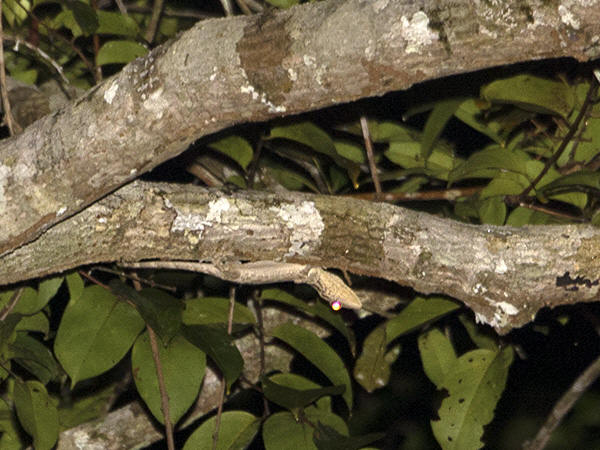
Fig 1

Fig 2

Fig 3

Fig 4

Fig 5
|
Family : GEKKONIDAE
Species : Gekko smithii / Gekko hulk
Size (snout to vent) : up to 19 cm
Size (total length) : up to 40 cm
Play call
►
Gekko smithii /
Gekko hulk (Large Forest Gecko) inhabits primary forest and swamp forest from the lowlands
to around 1000 metres elevation. It is strongly arboreal and typically
occurs high in the canopy, where it often clings to tree trunks face-down.
In Peninsular Malaysia it also occurs on rocky islands, where it takes
refuge amongst large boulders (Grismer, 2011).
It also occurs beneath
the roofs of huts or cabins at the forest edge, where artificial lighting
attracts insect prey.
This huge gecko is more often heard than seen; its distinctive call can be
heard both day and night. The call is similar in tone to that of Gekko
gecko (Tokay Gecko), and typically comprises 3 to 7 short croaks,
followed by a final croak which is lower in pitch and longer in duration.
In the field Gekko smithii / Gekko hulk can be identified by its large size,
overall brown colour, dark bands across its dorsum and tail, and rows of
white spots. Its head is large, and its eyes are green with vertical pupils.
The body bears numerous tubercles.
There is some geographic variation in colour and patterning.
Gekko smithii / Gekko hulk occurs in the Sunda region including southern Thailand
and Peninsular
Malaysia, and the islands of Borneo, Sumatra and Java.
In Singapore it appears to have become locally extinct; its loud call, which
was once easily heard in remnant areas of primary lowland forest, has not
been heard for a decade or two. It was not recorded during a comprehensive
survey of Bukit Timah Nature Reserve in 2015-2016 (Teo & Thomas, 2019).
Fig 1 : Fully-grown adult clinging to the trunk of a dead tree by day.
Its resting hole is at bottom left. Seen at South Belum Forest Reserve, northern Peninsular Malaysia.
Fig 2 : This example was found navigating across bare, denuded ground in
Panti Forest, Johor, Peninsular Malaysia.
Fig 3 : Example clinging to the underside of a horizontal branch at night,
high in the canopy at Panti Forest, Johor, Peninsular Malaysia.
Fig 4 : Adult example from Lambir Hills, Sarawak, Borneo, feeding on a large
cicada attracted to the lights of a hut near the forest edge.
Fig 5 : Juvenile from Lambir Hills, Sarawak, Borneo found on a
hut at the forest edge.
References :
Grismer, L. L., 2011. Lizards of Peninsular Malaysia, Singapore and their
Adjacent Archipelagos. Edition Chimaira. 728 pp.
Teo, R. C. H., & Thomas, N. J. (2019). Updated inventory of amphibians,
reptiles and mammals of the Bukit Timah Nature Reserve, Singapore. Gardens
Bulletin, Singapore, 71(Suppl 1), 145-183.
|